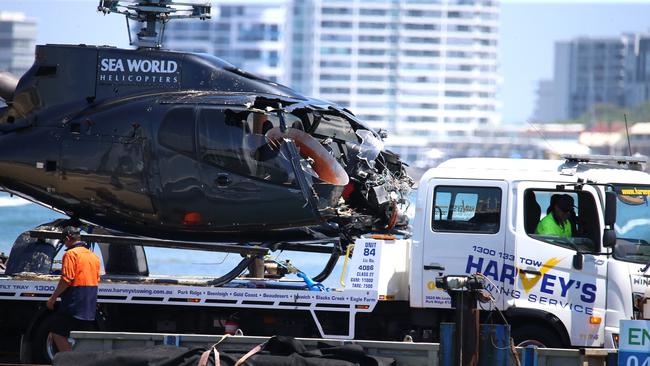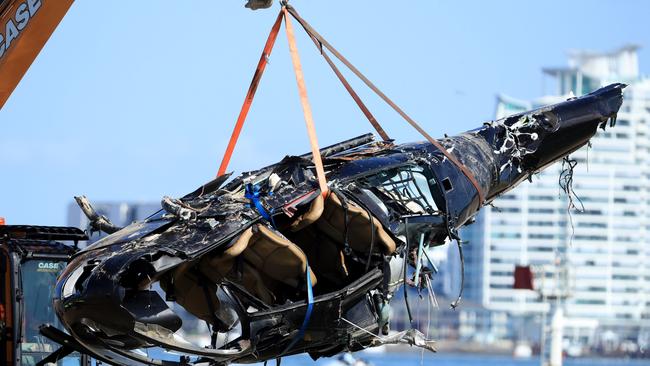Gold Coast helicopter company investigated over two other incidents
A company behind the helicopters involved in the Gold Coast tourist tragedy has been at the centre of two other investigations including one where three people including the pilot were seriously injured.
QLD News
Don't miss out on the headlines from QLD News. Followed categories will be added to My News.
The company behind the helicopters involved in the Gold Coast tourist tragedy has been at the centre of two other investigations including one where three people including the pilot were seriously injured.
As investigators hunt for clues to what caused Monday’s crash killing four people, it can be revealed that a chopper operated by Professional Helicopter Services made an emergency landing onto a sand dune during an Uluru sightseeing flight in January 2018.
The pilot and three passengers were injured and the Australian Transport Safety Bureau (ATSB) found the company’s passenger scales were not calibrated and were under‑reading the actual occupant weights.
In February last year an instructor had to take over during a training flight with a student after the tail rotor and stabiliser assemblies had separated from the rear of the tail boom and were sitting a short distance away, according to the ATSB.
Neither of those choppers were EC 130 B4s which were involved in this week’s fatal crash.

Registration details show the helicopter which smashed into the sandbank, VH-XKQ, was built in France in 2008 by what is now Airbus Helicopters and registered to Sea World Helicopters on November 2 last year.
The surviving Sea World Helicopter chopper which was seriously damaged but landed safely, VH-XH9, was built in France in 2004 and registered to the company on November 3 last year.
A spokesperson for Sea World Helicopters said it was a separate company to Professional Helicopter Services and the “only commonality is some management oversight due to the nature of the owner’s investment.”
John Orr-Campbell, 66, is the chairman and managing director of both Professional Helicopter Services and Sea World Helicopters as well as a director and secretary of both companies which share the same business address in Hampton, Victoria. snir.
“According to the safety regulator, CASA, both entities are separate, they are audited by the regulator separately and they have their own infrastructure and staffing. The only commonality is the nature of the owner’s investment.
“Sea World Helicopters has been audited by CASA as required as well as a third-party aviation audit expert. The latest audit found ‘because of SWH’s continued quality assurance and managerial commitment that the company is in step with regulatory requirements and with industry best practice.”
EC 130s can carry up to seven passengers with three in front and four in the rear.

Professional Helicopter Services, based at Melbourne’s Moorabbin Airport, also operates from the Gold Coast, Uluru and Kings Canyon with its website page stating they run the country’s longest-running flight training school and conduct fire fighting, aerial photography, geological and mining surveys, pipeline and powerline patrols, cherry drying and frost protection as well as scenic flights.
John Orr-Campbell, 66, is the chairman and managing director of both Professional Helicopter Services and Sea World Helicopters as well as a director and secretary of both companies.
It was on a tourist flight at about 6.30pm on January 17, 2018 when the Robinson R44 helicopter, registered VH-HGX, with a pilot and three passengers o board got into trouble after taking off from the Yulara Town helipad for a flight over Uluru.
The pilot had flown the same departure with a full load of passengers on three previous flights but this time the rotations per minute (RPM) decayed as the chopper climbed to 200ft. The ATSB found the pilot had “inadvertently adopted a practice of conducting the rotors running turn-around (for passenger transfers)” without switching on what is called the “governor” which maintains desired rotor speed.

The ATSB also found that Professional Helicopter Services had not calibrated the passenger scales which had under‑read the actual occupant weights which led to the helicopter operating at a higher weight than planned which “increased the risk of their helicopters not achieving their take-off performance”.
The chopper company co-operated with the ATSB inquiry which reported that “pilots should ensure they understand the purpose behind all checklist items, and if any doubt exists, seek clarification to reduce the likelihood of misunderstanding the requirements”.
A second ATSB inquiry into the separation of the tail assembly from a Robinson R22 helicopter, registered VH-THM, at Gold Coast Airport on February 26 last year is ongoing.

A student pilot with an instructor was conducting a low-level hover exercise, during which it was reported that the helicopter‘s nose pitched up, a large vibration was felt through the airframe, and the helicopter started to yaw to the right. The ATSB reported that the instructor took over and landed safely but are investigating how the tail rotor and stabiliser assemblies had separated from the rear of the tail boom.
“ATSB investigators will conduct a detailed examination of the recovered physical components, relevant maintenance documentation, and speak to the pilots and any witnesses,” the bureau said after last year’s incident.
The EC 130s involved in this week’s tragedy operate with an enclosed tail fan anti-torque device, known as a Fenestron, replacing the traditional tail rotor.
Professional Helicopter Services has been approached for comment.
More Coverage
Originally published as Gold Coast helicopter company investigated over two other incidents




